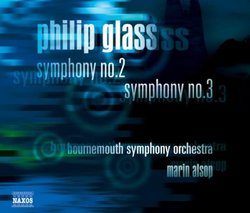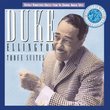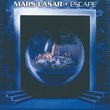| All Artists: Philip Glass, Marin Alsop, Bournemouth Symphony Orchestra Title: Philip Glass: Symphonies Nos. 2 & 3 Members Wishing: 3 Total Copies: 0 Label: Naxos American Release Date: 11/16/2004 Genres: Pop, Classical Styles: Easy Listening, Historical Periods, Modern, 20th, & 21st Century, Symphonies Number of Discs: 1 SwapaCD Credits: 1 UPC: 636943920220 |
Search - Philip Glass, Marin Alsop, Bournemouth Symphony Orchestra :: Philip Glass: Symphonies Nos. 2 & 3
 | Philip Glass, Marin Alsop, Bournemouth Symphony Orchestra Philip Glass: Symphonies Nos. 2 & 3 Genres: Pop, Classical
Marin Alsop ? Bournemouth Symphony Orchestra Philip Glass (b.1937): Symphonies nos. 2 & 3 Though he prefers not to be labeled a 'minimalist' composer, that is the style with which Philip Glass is most associated. His ... more » |
Larger Image |
CD DetailsSynopsis
Album Description Marin Alsop ? Bournemouth Symphony Orchestra Philip Glass (b.1937): Symphonies nos. 2 & 3 Though he prefers not to be labeled a 'minimalist' composer, that is the style with which Philip Glass is most associated. His compositions, however, though bearing certain tradmarks, employ a great range of techniques. This adaptive ability contributes to his success as a composer of music ranging from string quartets to largescale orchestral works and mammoth film scores. Marin Alsop conducts her Bournemouth symphony orchestra in these amazing performances of the Second and Third symphonies of legendary American composer Philip Glass. The grand Second Symphony was comissioned by the Brooklyn Acadamy of Music and premiered there in 1994 by Dennis Russell Davies. Also a commissioned work, the Third Symphony is composed for chamber orchestra, and thus bears an intimacy that is brilliantly suited to a smaller ensemble. In both the epically-proportioned Second Symphony and the smaller-scale Third Symphony, Glass returns, in his own way, to his roots at the Juilliard School, writing polyharmonies, rousing finales, and fully-formed symphonic paragraphs. They are true symphonies in scope, structure and seriousness of purpose. Marin Alsop comments on this recording: "Conducting and recording the music of Philip Glass is the completion of a circle for me. I first met Philip Glass in the late 1970s when I started playing violin on some of his recording projects. The new music scene in Manhattan was one of my major inspirations at that time, so working closely with Philip and his ensemble was a dream come true. I had not seen Philip since the mid 1980s until he attended an all Glass concert that I conducted in London. Like his music, it felt like the contuniation of an old friendship, only changed in a simple but profound way." Similarly Requested CDs
|
CD ReviewsGlass Deepens With Two Dramatically Resonant Pieces Ed Uyeshima | San Francisco, CA USA | 04/23/2005 (5 out of 5 stars) "Along with his colleague John Adams, Philip Glass is the most familiar of the modern minimalists. Yet like Adams, Glass seems to be building a greater communicative sense with each new work I hear. These two symphonies were composed in the early nineties, and Naxos is now providing a 2003 recording of the Bournemouth Symphony Orchestra led by the insightful Marin Alsop. This is the same group of artists that played the wonderful version of Adams' "Shaker Loops" this past year, and this recording of Glass' works equals that one for dramatic insight and virtuosic preciseness. A strings-only piece, Symphony #3 (23:58) has four conventional movements which build in drama and texture. It contains many of Glass' signature sounds with mono-tonal melodies that spiral in larger and larger circles and chords that feel like they are beating down an urban thunderstorm of clandestine activity - jabbing, throbbing, chugging - as they do in the second movement. Yet the music reflects some of his most gentle work especially in the first and third movements. There is an unexpectedly beautiful violin solo in the middle of the third movement that runs initially counter to his quietly driving sequential style until they eventually meld together. The drama turns fiery in the last movement as it broadens into an exciting albeit measured gallop, at the same time not sacrificing the virtuosity of the expert playing by the Bournemouth string section. Symphony #2 (43:14) is a larger scale piece that makes dramatic sense to be played after the third, as it is a more ambitious work. It slowly builds in intensity with very broad strokes that deepen and darken when it comes to the bass-lines and the repetitive use of contrasting woodwinds. There is a vividly harrowing sense of adventure to the first movement that this section would not be inappropriate to be used as background movie music for a daring escape aboard a hot air balloon crossing the Alps. There is more of an orchestral sense to the second movement and an increasing ambiguity in tone that heightens the drama considerably with yet a new set of pronounced textures. The finale has almost a battle-cry exuberance but with a swooping, sinuous dramatic power with the addition of brass and even bells to the strings and woodwinds. The last movement truly feels like the culmination of what Glass has presented before in both symphonies. Beautifully recorded at "The Concert Hall, Lighthouse, Poole" in Dorset, UK, this recording verifies that Glass' oeuvre is more than his famous operas often in collaboration with Robert Wilson. Producer-engineer Tim Handley has done an excellent job of keeping the impeccable sound in check throughout. And like the Adams recording, this one sells for the ridiculously bargain basement price of $6.98. Strongly recommended." Defies the theory that Glass's orchestral works are weak James G. Glicker | Baltimore, MD United States | 12/26/2004 (4 out of 5 stars) "I bought this CD simply on impulse (it was on sale for $5.99) but it turned out to be a rewarding purchase. I have always thought of Glass's great works to be his operas and smaller pieces (Glassworks etc.) but the pairing of these two powerful orchestral works makes you wonder if his symphonies are underrated (and certainly underperformed). Alsop creates a unified structure that makes a more compelling case than the previous recording of the 3rd (I don't have any comparison for the 2nd). Bournemouth, as everybody knows, is a fine orchestra, but really shines when Alsop asks them to provide a little more 'oomphh' than is usually called for in Glass works. No serious contemporary collector should miss this set, and at the price I'd buy one for a friend." Lovable David Saemann | 06/02/2008 (5 out of 5 stars) "I am a late convert to the music of Philip Glass. I was skeptical of it for a long time. Then I heard the Metropolitan Opera broadcast of his opera Satyagraha, which I was surprised to find had solid musical values. The same is true of the current CD. I don't think Glass is Bartok or Prokofiev, but that's not the point. He certainly can be mentioned in the same breath as an earlier American master like Howard Hanson. Indeed the Second Symphony, despite its minimalism, has melodies and structures reminiscent of the symphonic masters of the middle of the last century. Glass has said that the writing of Honegger and Milhaud in symphonic form still offers avenues for exploration, and he gleefully picks up their torch in this work. Surprising for minimalism, it even has a real finale that's reminiscent of the first two symphonies of Charles Ives. I have read a published review of this album that calls both works "unrepentant minimalism." That simply isn't true. The Third Symphony, written for 19 string players, is a beautifully accomplished piece of music. At times, particularly in the second movement, it is reminiscent of Stravinsky's concertos for strings. And in the sonorities of the last movement, there is even an evocation (unintentional?) of Andrew Lloyd Webber's Phantom of the Opera. This is a very enjoyable disc, beautifully played and recorded."
|

 Track Listings (7) - Disc #1
Track Listings (7) - Disc #1








